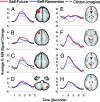Neural substrates of envisioning the future
- PMID: 17202254
- PMCID: PMC1761910
- DOI: 10.1073/pnas.0610082104
Neural substrates of envisioning the future
Abstract
The ability to envision specific future episodes is a ubiquitous mental phenomenon that has seldom been discussed in the neuroscience literature. In this study, subjects underwent functional MRI while using event cues (e.g., Birthday) as a guide to vividly envision a personal future event, remember a personal memory, or imagine an event involving a familiar individual. Two basic patterns of data emerged. One set of regions (e.g., within left lateral premotor cortex; left precuneus; right posterior cerebellum) was more active while envisioning the future than while recollecting the past (and more active in both of these conditions than in the task involving imagining another person). These regions appear similar to those emerging from the literature on imagined (simulated) bodily movements. A second set of regions (e.g., bilateral posterior cingulate; bilateral parahippocampal gyrus; left occipital cortex) demonstrated indistinguishable activity during the future and past tasks (but greater activity in both tasks than the imagery control task); similar regions have been shown to be important for remembering previously encountered visual-spatial contexts. Hence, differences between the future and past tasks are attributed to differences in the demands placed on regions that underlie motor imagery of bodily movements, and similarities in activity for these two tasks are attributed to the reactivation of previously experienced visual-spatial contexts. That is, subjects appear to place their future scenarios in well known visual-spatial contexts. Our results offer insight into the fundamental and little-studied capacity of vivid mental projection of oneself in the future.
Conflict of interest statement
The authors declare no conflict of interest.
Figures

Similar articles
-
Remembering what could have happened: neural correlates of episodic counterfactual thinking.Neuropsychologia. 2013 Oct;51(12):2401-14. doi: 10.1016/j.neuropsychologia.2013.01.015. Epub 2013 Jan 31. Neuropsychologia. 2013. PMID: 23376052 Free PMC article.
-
Contextual processing in episodic future thought.Cereb Cortex. 2009 Jul;19(7):1539-48. doi: 10.1093/cercor/bhn191. Epub 2008 Nov 2. Cereb Cortex. 2009. PMID: 18980949
-
When the future becomes the past: Differences in brain activation patterns for episodic memory and episodic future thinking.Behav Brain Res. 2010 Oct 15;212(2):196-203. doi: 10.1016/j.bbr.2010.04.013. Epub 2010 Apr 21. Behav Brain Res. 2010. PMID: 20399235
-
Parietal and hippocampal contribution to topokinetic and topographic memory.Philos Trans R Soc Lond B Biol Sci. 1997 Oct 29;352(1360):1437-48. doi: 10.1098/rstb.1997.0130. Philos Trans R Soc Lond B Biol Sci. 1997. PMID: 9368932 Free PMC article. Review.
-
Envisioning Patient Safety in the Year 2025: Eight Perspectives.In: Henriksen K, Battles JB, Keyes MA, Grady ML, editors. Advances in Patient Safety: New Directions and Alternative Approaches (Vol. 1: Assessment). Rockville (MD): Agency for Healthcare Research and Quality; 2008 Aug. In: Henriksen K, Battles JB, Keyes MA, Grady ML, editors. Advances in Patient Safety: New Directions and Alternative Approaches (Vol. 1: Assessment). Rockville (MD): Agency for Healthcare Research and Quality; 2008 Aug. PMID: 21249853 Free Books & Documents. Review.
Cited by
-
Mental simulation of routes during navigation involves adaptive temporal compression.Cognition. 2016 Dec;157:14-23. doi: 10.1016/j.cognition.2016.08.009. Epub 2016 Aug 29. Cognition. 2016. PMID: 27568586 Free PMC article.
-
Remembering what could have happened: neural correlates of episodic counterfactual thinking.Neuropsychologia. 2013 Oct;51(12):2401-14. doi: 10.1016/j.neuropsychologia.2013.01.015. Epub 2013 Jan 31. Neuropsychologia. 2013. PMID: 23376052 Free PMC article.
-
The Cerebellum Gets Social: Evidence from an Exploratory Study of Cerebellar, Neurodevelopmental, and Psychiatric Disorders.Biomedicines. 2023 Jan 22;11(2):309. doi: 10.3390/biomedicines11020309. Biomedicines. 2023. PMID: 36830846 Free PMC article.
-
Flexible memories: differential roles for medial temporal lobe and prefrontal cortex in cross-episode binding.J Neurosci. 2010 Nov 3;30(44):14676-84. doi: 10.1523/JNEUROSCI.3250-10.2010. J Neurosci. 2010. PMID: 21048124 Free PMC article.
-
My future is brighter than yours: the positivity bias in episodic future thinking and future self-images.Psychol Res. 2020 Oct;84(7):1829-1845. doi: 10.1007/s00426-019-01189-z. Epub 2019 Apr 29. Psychol Res. 2020. PMID: 31037451
References
-
- Suddendorf T, Corballis MC. Genet Social Gen Psychol Monogr. 1997;123:133–167. - PubMed
-
- Tulving E. Stuss DT, Knight RC. Principles of Frontal Lobe Function. New York: Oxford Univ Press; 2002. pp. 311–325.
-
- Fuster JM. The Prefrontal Cortex Anatomy, Physiology, and Neuropsychology of the Frontal Lobe. 2nd Ed. New York: Raven; 1989.
-
- Shallice T. From Neuropsychology to Mental Structure. Cambridge, UK: Cambridge Univ Press; 1988.
-
- Stuss DT, Benson DF. The Frontal Lobes. New York: Raven; 1986.
MeSH terms
LinkOut - more resources
Full Text Sources
Miscellaneous

